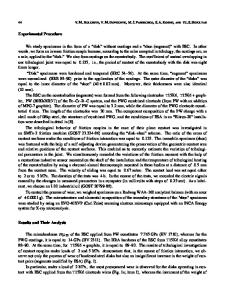Friction and Wear of ZrN Coatings under Conditions of Microcontact Using Atomic-Force Microscopy
- PDF / 1,584,287 Bytes
- 8 Pages / 612 x 792 pts (letter) Page_size
- 37 Downloads / 354 Views
tion and Wear of ZrN Coatings under Conditions of Microcontact Using Atomic-Force Microscopy T. Kuznetsovaa, *, V. Lapitskayaa, B. Warcholinskib, A. Gilewiczb, and S. Chizhika aA.V.
Luikov Institute of Heat and Mass Transfer of the National Academy of Sciences of Belarus, Minsk, 220072 Belarus b Koszalin University of Technology, Koszalin, Poland *e-mail: [email protected] Received September 27, 2019; revised April 24, 2020; accepted April 29, 2020
Abstract—ZrN coatings were formed by magnetron sputtering at various rates of nitrogen flow in the reaction chamber: 3, 4, 5, and 6 cm3/min. The thickness of the ZrN coatings was approximately 3 μm. Using atomic force microscopy (AFM), we studied the surface morphology; roughness; coefficient of friction Сfr; specific volumetric wear ω of ZrN coatings with the construction of Сfr dependencies on the number of scan cycles; and specific volumetric wear on load, probe speed, number of scan cycles. It was found that the coating obtained at a nitrogen flow rate of 3 cm3/min has the lowest values of Сfr and ω. Keywords: coating, ZrN, microstructure, mechanical properties, friction, atomic force microscopy, coefficient of friction, specific volumetric wear DOI: 10.3103/S1068366620040078
INTRODUCTION The interaction of contacting surfaces of submicron and nanometer sizes has its own peculiarities as compared with parts of macrosizes [1, 2]. The influence of adhesion forces and capillary and electrostatic effects in microcontact cannot be neglected. The small size of contact allows creating an increased level of mechanical tensions, which exceed most loading tests from classical mechanical experiments. For adhesion strength determined by scratching and normal load of 80–100 N, the tensions constitute 20– 30 GPa [3], while at microwear by diamond probe with a load of 0.2 μN, tensions reach about 50 GPa [4]. The level of mechanical tensions especially increases upon contact with solid coatings with values of microhardness from 20 GPa and higher. Besides a high level of mechanical tensions, contact interactions at submicron and nanometer sizes are distinguished by a small depth of maximal tensions, which is limited by units to dozens of nanometers [4]. Such a peculiarity allows realizing a specific wear mode—removal of material from the surface in the form of nanometer layers in the technology of tip based micromachining (TBM) [5] and provide accuracy of contour, which is unreachable by classic technologies. In this way, it is possible to create complicated structures of new optical materials, MEMS sensors, and microchannels, where the third measurement is involved and precisely controlled. The use in mechanical treatment of probe methods with a nanometer radius of the “tool” and nanometer “feed
rate,” due to the precision displacement of the probe relative to the sample by piezo modules, provides the possibility of the appearance of basic elements of complex structures with dimensions on the order of dozens and units of nanometers in the plane and fractions of nanometers in height.
Data Loading...











